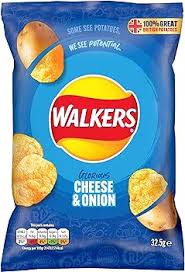A Flavorful Journey from Plain to Piquant
In today’s snack landscape, consumers are truly spoiled for choice when it comes to potato chips. Available in an astounding variety of flavors—from barbecue to salt and vinegar to even pizza-flavored Pringles—potato chips have become a beloved snack around the world. While they likely originated in the early to mid-19th century, it took over a century before the concept of flavored chips emerged.
The Birth of Flavor: Cheese and Onion Crisps

The first flavored potato chip emerged in Ireland during the 1950s, thanks to the Tayto snack company, which introduced the iconic “cheese and onion” flavored crisps. In the UK, these snacks are referred to as “crisps,” while “chips” denotes what Americans would call french fries. The introduction of cheese and onion crisps quickly captured the hearts of consumers, paving the way for an explosion of flavors in the years that followed, including classics like salt and vinegar, sour cream and onion, and barbecue.
Today, in the 21st century, cheese and onion crisps remain one of the most popular flavors in the UK, often associated with the Walkers brand. While salt and vinegar crisps frequently compete for the top spot, traditional salted crisps continue to hold their own in the market.
The Visionaries Behind the Flavor

The invention of potato chip flavors is credited to Joe “Spud” Murphy, the owner of Tayto, and his employee Seamus Burke, who began seasoning their crisps with cheese and onions in 1954. Prior to this innovation, potato chips were typically sold plain, with vendors offering small packets of salt for customers to sprinkle on themselves. Murphy and Burke’s approach to pre-seasoning transformed the way chips are marketed, making it uncommon to find unseasoned chips on store shelves today, except for those prepared at home.
Tayto initially launched its cheese and onion flavor alongside two other simple varieties: plain crisps and cheese-flavored crisps. Soon after, they introduced the salt and vinegar flavor, achieved by applying a thin coating of vinegar to a starchy powder that served as seasoning. Many of these early chip flavors mirrored toppings commonly found on traditional potato dishes, such as baked potatoes topped with shredded cheese, onions, and salt.
A Global Expansion of Potato Chip Flavors
In the United States, the journey of flavored potato chips took a different path but ultimately led to a similar level of popularity. The first flavored chip to hit the American market was barbecue, introduced by Herr’s potato chips in 1958. By the end of the 1970s, the sour cream and onion flavor gained traction in the U.S., echoing the success of the original cheese and onion flavor.
However, when it comes to the most popular chip flavors in the U.S., the landscape differs from that of the UK. According to World Metrics, the most popular chip flavor in the United States is actually plain, with barbecue coming in a distant No. 2. Sour cream and onion holds the third position. This indicates that Americans are not as fond of onion seasoning in their chips, or much seasoning at all, aside from the hefty amount of salt found in plain potato chips. Instead, there is a robust culture around dips for both potato and tortilla chips, with a variety of potato chip dip ingredients ranging from onion dip to ketchup.
From its humble beginnings with the cheese and onion flavor to the vast array of options available today, the story of potato chips is one of innovation and adaptability. As consumers continue to seek out exciting new flavors and combinations, the legacy of the first potato chip flavor remains a cherished staple, particularly in the UK. The evolution of this beloved snack serves as a reminder of how culinary creativity can transform simple ingredients into something extraordinary.

















